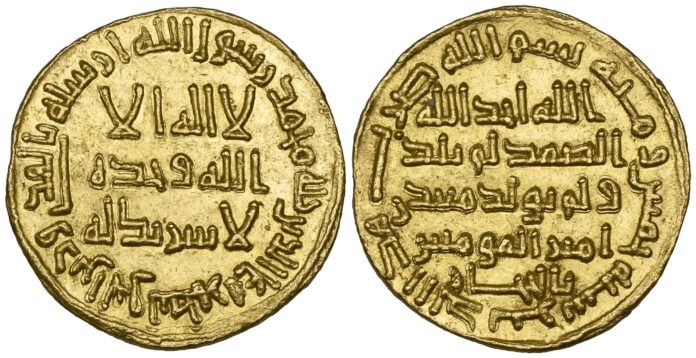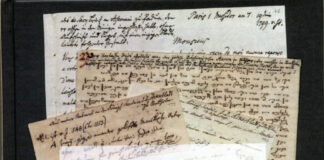One of the Rarest Islamic Gold Coins
One of the world’s rarest and most highly-prized of all Islamic gold coins is to be offered for auction in London on Thursday 24 October 2019 by Morton & Eden in their Auction 103 “Important Coins of the Islamic World”.
“This dinar is among the most sought-after of all early Islamic coins and represents the ultimate to which any collector of early Islamic coins can aspire,” says Stephen Lloyd, Morton & Eden Islamic coins specialist.
Measuring a mere 20mm across, about the size of a modern £1 piece, the gold coin has an auction estimate of £1.4-1.6million. This is the highest estimate for any lot previously offered for sale by specialist auctioneers Morton & Eden.
Made from Gold of the Caliph Himself
The reason for this expensive price tag is the fact that this Umayyad dinar, dated 105h (723AD), bears a short line of text Ma‘din Amir al-Mu‘minin, which translates as ‘Mine of the Commander of the Faithful.’ In other words it states that the dinar was made from gold mined at a location owned by the Caliph himself. As the successor to the Prophet Muhammad, the Caliph was all-important. He was the supreme religious and political leader of the early Islamic state, making this the ultimate provenance for any Islamic relic.
What makes this dinar even more desirable is the fact that it bears the additional legend “bi’l-Hijaz” affirming that the mine was located “in the Hejaz”, located between the Holy Cities of Makka and al-Madina, in the west of present day Saudi Arabia. Prior to the mine being owned by the Caliph, the previous owner had acquired the land directly from the Prophet Muhammad adding further importance to the coin. In essence this is the first Islamic gold coin to name a location in Saudi Arabia, and indeed the earliest from the Gulf Region as a whole.
The Other Specimen Set a Record
Only about a dozen of these coins are known today, and almost all are now held in private collections or major international museums. This is only the second specimen ever to be offered at public auction. The other was also auctioned by Morton & Eden in 2011 when it sold for an astonishing £3.72million, setting a record price for any Islamic coin and for any coin sold at auction in Europe.
“This coin is fabulous. Not only is it beautifully preserved and an astonishing rarity but it is also an important historical document,” said Morton & Eden Islamic coins specialist Stephen Lloyd. “Scholars have identified the site of the mine itself as Ma’din Bani Sulaim, located north-west of the Holy City of Mecca.”
Still Under Debate Where the Coin Was Minted
Gold has been mined in this region for thousands of years, and the site is still worked today. Remarkably, mediaeval Arab writers record that the Caliph bought a piece of land in this area, containing at least one gold mine, almost exactly when these coins were made. But while there is general agreement on the source of the gold, the question of exactly where these coins were struck is harder to answer.
“The capital, Damascus, is a possibility, but mint workers and their tools could easily have travelled with the Caliph and struck coins wherever he stayed,” Stephen Lloyd said. “Scholars have noted that the caliph himself was in the vicinity of Mecca late in the year 105 when this coin was struck, and a pilgrimage road to the Holy City went right past this mine.
“So one plausible theory argues that the Caliph visited his gold mines while en route for Mecca, and it is possible these coins might have been struck while he was travelling.
“Regardless, these dinars remain among the most sought-after of all early Islamic coins and represent the ultimate to which any collector of early Islamic coins can aspire.”
The coin has been consigned for sale by a private collector.
The sale, held by Morton & Eden, will take place on October 24, 2019 in one of Sotheby’s London salerooms.
For further information on the auction house go to the Morton & Eden website.
There is available a PDF version of the auction catalogue.
You can find the online catalogue for live-bidding at NumisBids.




